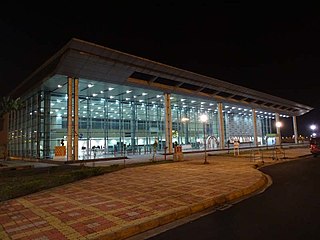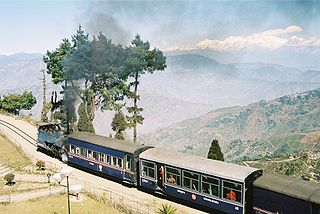
Transport in India consists of transport by land, water and air. Road transport is the primary mode of transport for most Indian citizens, and India's road transport systems are among the most heavily used in the world.

West Bengal is a state in the eastern portion of India. It is situated along the Bay of Bengal, along with a population of over 91 million inhabitants within an area of 88,752 km2 (34,267 sq mi) as of 2011. The population estimate as of 2023 is 102,552,787. West Bengal is the fourth-most populous and thirteenth-largest state by area in India, as well as the eighth-most populous country subdivision of the world. As a part of the Bengal region of the Indian subcontinent, it borders Bangladesh in the east, and Nepal and Bhutan in the north. It also borders the Indian states of Jharkhand, Odisha, Bihar, Sikkim and Assam. The state capital is Kolkata, the third-largest metropolis, and seventh largest city by population in India. West Bengal includes the Darjeeling Himalayan hill region, the Ganges delta, the Rarh region, the coastal Sundarbans and the Bay of Bengal. The state's main ethnic group are the Bengalis, with the Bengali Hindus forming the demographic majority.

Netaji Subhash Chandra Bose International Airport is an international airport serving Kolkata and the Kolkata Metropolitan Region. It is the primary aviation hub for eastern and northeastern India. It is located approximately 15 kilometres (9.3 mi) from the city centre. The airport is locally known as Kolkata Airport and Dum Dum Airport before being renamed in 1995 after Subhas Chandra Bose, one of the most prominent leaders of the Indian independence movement, from Bengal. The airport's IATA code CCU is associated with "Calcutta", the former legal name of the city. Opened in 1924, Kolkata Airport is one of the oldest airports in India.

Grand Chord is part of the Howrah–Gaya–Delhi line and Howrah–Prayagraj–Mumbai line. It acts as a link between Sitarampur, (Asansol), and Pt. Deen Dayal Upadhyay Junction,, previously known as Mughalsarai Junction, and covers a stretch of 450.7 km (280.1 mi). The Coal India Corridor line that branches off from Dhanbad Junction and rejoins the Grand Chord at Son Nagar Junction is another major coal loading hub. It is a fully electrified, quadruple line section from Pt. Deen Dayal Upadhyay to Son Nagar and double line section from Son Nagar to Sitarampur. There are plans to triple the lines from Son Nagar to Dhanbad to accommodate the increasing traffic.. The entire line lies under the jurisdiction of three divisions, Mughalsarai railway division, Dhanbad railway division and Asansol railway division. The Grand chord section is the lifeline of the country, 2nd busiest railway section of India after Ghaziabad, Uttar Pradesh to Pt. Deen Dayal Upadhyay Junction, Uttar Pradesh Main Line section, on which coal, steel and other important goods are moved from Eastern section to Western and Northern sections of the country. In the down direction, the traffic consists of mostly food grains, fertilizers and empty wagons for coal loading in the Jharkhand and West Bengal coal fields. Pt. Deen Dayal Upadhyay Junction is a transit division and the main objective is to maintain mobility of high density traffic. The present capacity of the Grand Chord is being optimally utilized. Traversing through Chota Nagpur Plateau of Jharkhand as well as parts of the fertile Gangetic plains of Bihar, the Grand Chord covers a stretch of 450.7 km (280.1 mi). The Grand Chord is renowned for its remarkable controlling of passenger traffic, despite being burdened with freight traffic.

Haldia is an industrial port city in Purba Medinipur district in the Indian state of West Bengal. It has a major river port and industrial belt located approximately 124 km (77 mi) southwest of Kolkata near the mouth of the Hooghly River, one of the distributaries of the Ganges. The Haldia Township is bordered by the Haldi River, an offshoot of the Ganges River. Haldia is a centre for petrochemical businesses, and is a major trade port for Kolkata.

Chennai Port, formerly known as Madras Port, is the second largest container port of India, behind Mumbai's Jawaharlal Nehru Port also known as Nhava Sheva. The port is the largest one in the Bay of Bengal. It is the third-oldest port among the 13 major ports of India with official port operations beginning in 1881, although maritime trade started much earlier in 1639 on the undeveloped shore. It is an artificial and all-weather port with wet docks. Once a major travel port, it became a major container port in the post-Independence era. An established port of trade of British India since the 1600s, the port remains a primary reason for the economic growth of Tamil Nadu, especially for the manufacturing boom in South India, and has contributed greatly to the development of the city of Chennai. It is due to the existence of the port that the city of Chennai eventually became known as the Gateway of South India.

Paradeep, also spelled Paradip, is a major industrial seaport city and municipality, 53 km (33 mi) from Jagatsinghpur city, in Jagatsinghpur district of Odisha, India. Paradeep was constituted as an NAC on 27 September 1979 and converted into a municipality on 12 December 2002. The nearest commercial airport is Biju Patnaik International Airport.

Port of Kolkata or Kolkata Port, officially known as Syama Prasad Mookerjee Port, is the only riverine major port in India, in the city of Kolkata, West Bengal, around 203 kilometres (126 mi) from the sea. It is the oldest operating port in India and was constructed by the British East India Company. Kolkata is a freshwater port with no variation in salinity. The port has two distinct dock systems – Kolkata Dock at Kolkata and a deep water dock at Haldia Dock Complex, Haldia.

Inland Waterways Authority of India (IWAI) is the statutory authority in charge of the waterways in India. It was constituted under IWAI Act-1985 by the Parliament of India. Its headquarters is located in Noida, Uttar Pradesh.

The economy of Odisha is one of the fastest growing economies in India. According to 2014-15 economic survey, Odisha's gross state domestic product (GSDP) was expected to grow at 8.78%. Odisha has an agriculture-based economy which is in transition towards an industry and service-based economy.

The Howrah–Kharagpur line is part of the Howrah–Nagpur–Mumbai line, Howrah–Chennai main line and Kolkata Suburban Railway.

Kazi Nazrul Islam Airport is a domestic airport mainly serving the city of Durgapur and also Asansol. It is located at Andal region of Durgapur in Paschim Bardhaman district in the Indian state of West Bengal. It is named after the renowned Bengali poet, Kazi Nazrul Islam. The airport is roughly 39 km (24 mi) from Asansol and 21 km from Raniganj.
Sagar Port is a proposed seaport in Sagar Island, West Bengal, India by the Government of India and Government of West Bengal. IIT Madras has been engaged to prepare a detailed project report (DPR) for the port, involving studies for shore-protection, land reclamation and physical modeling for use of dredge material. Cost of the port build up will be ₹30 billion. The port is scheduled to have an initial capacity to handle 60 million tonnes of bulk and containerised cargo. A rail cum road bridge over the Muriganga river is proposed to connect the Sagar Island to the mainland via Kakdwip. The length of rail-road bridge is 3.3 km.
Ports in West Bengal support international trade. Since ancient times, trade in West Bengal has been closely related to the river and seaports. The waterways have still not lost their importance. The primary port in the eastern Indian state of West Bengal is the Port of Calcutta. This Port is managed by the Calcutta Port Trust.

The Haldia Port, officially Haldia Dock Complex (HDC), is a port on the confluence of the Haldi River and the Hooghly River. The port is located at Haldia in West Bengal, about 130 kilometres (81 mi) from the sandheads–deep sea area of the Bay of Bengal, 45 kilometres (28 mi) upstream from Pilotage Station at Sagar and 104 km downstream of Kolkata. In 1968, an oil jetty was commissioned at Haldia, and officially in 1977 the port facility of Haldia started functioning as a subsidiary port of the Port of Kolkata under the name Haldia Dock Complex.
Tajpur Port is a proposed greenfield deep-sea port in Tajpur, East Midnapore district, West Bengal. The port will be built on the coast of Bay of Bengal near Tajpur. The construction of the port was awarded to the Adani Ports and Special Economic Zone Limited in September, 2022. Chief Minister Mamata Banerjee handed over Letter of Intent (LoI) to build the port to Karan Adani, son of Adani Group Chairman Gautam Adani, at the "Bijaya Sammelani" organized on October 12, 2022 at Eco Park, New Town, Kolkata. After the construction of the port, it will be the first deep-sea port in West Bengal. It is estimated that the port will be constructed at a cost of ₹25,000 crores.
Water transport in India has played a significant role in the country's economy and is indispensable to foreign trade. India is endowed with an extensive network of waterways in the form of rivers, canals, backwaters, creeks and a long coastline accessible through the seas and oceans. It has the largest carrying capacity of any form of transport and is most suitable for carrying bulky goods over long distances.

Total length of road in West Bengal is 92,023 kilometers. Among these national highway are 2,377 kilometers, and state highway 2,393 kilometers. The road density of the state is 103.69 kilometers per 100 square kilometers ; the national density is 74.7 kilometers per 100 square kilometers. The average speed of the road in the state is between 40 and 50 kilometers/hour. The speed in the village and urban areas is between 20 and 25 kilometers/hour. This is the main reason the road is low and lack of maintenance. The total length of the railway line in the state is 3,825 kilometers. Indian Railways' Eastern Railway zone and South Eastern Railway zone Headquarter are located in Kolkata. The railways on the north side of the state Under the Northeast Frontier Railway. Kolkata Metro is India's first underground metro rail service. The Darjeeling Himalayan Railway, part of the Northeast Frontier Railway, is a UNESCO World Heritage Site.























